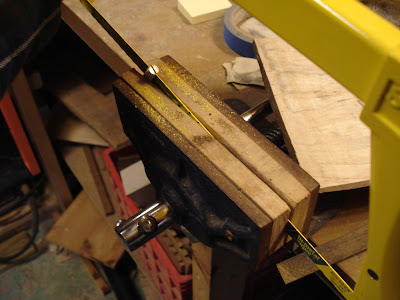*Subsurface contamination modeling...not swimsuit.
Yeah, it does. But I wasn't.
I decided instead to prototype a bow saw. Here's a fine example of one. It's typical on homemade versions to use a length of bandsaw blade for the blade. I happened to have an old one sitting around, so I was in business. Typically you drill a hole in either end of the blade and run a pin through it to attach it to the frame. The only problem is that these holes have to be at fairly precise lengths to make it work. I don't have much faith in my precision, so I thought of a work-around. The brace of my saw would meet the two arms at pivoting mortise and tenons that would allow for a large margin of error in overall blade length. If you don't understand, keep going; a picture is worth 1000 words.
I had a nice scrap of maple lying around. Looks like a potential saw, doesn't it? Lilah thought so too.
Then I cut it down...
As you can see, it's really starting to look like an actual tool by now.
Then I just eyeballed a shape for the arms and bandsawed them.
Then I chopped my mortises into the arms where they join the brace. Next I needed to cut the inside curve along the mortise shoulders. Here's how I got uniform curves:
An arm is in the background and a piece of scrap wood is in the foreground. I centered the scrap wood to the center of where the mortise was and swung an arc with a compass. Then I cut the arc out with a coping saw:
Next it was time to cut the tenons for the brace. I'm not aware a tool that would work really well for cutting a curved shoulder, so I just roughed it out and then trimmed away:
I suppose a compass-shoulder plane would be ideal for this job...the problem is that I don't think they exist. This theoretical tool would be a combination of this and this.
Anyway, once the brace was finished I had a rough bow saw:
So you can see now how the arms can pivot to accommodate slightly different length blades. Anyone see a problem with this design? At this point I didn't either.
Now it was time for the hardware. I bought some 8mm bolts and ground flat sides opposite each other on the ends:
Next I needed to cut a slot for the blade to run between the two flat sides. Trying to start a hacksaw cut on the end of a bolt can be quite a trial so I helped myself out by using a sharpening file to start the groove:
Then I just used a hacksaw to cut the slot. Notice how the vise is used as a guide for the cut:
Then I drilled one side of the slot bigger than my pin bolt and the other side slightly smaller so that the bolt could tap it itself:
Now time to put it all together:
What happens is that by turning that stick in the middle, the string at the top of the arms tightens. This causes the arms to pivot on the brace and this is what tensions the saw blade. Believe it or not, this actually worked. There was, however, one detail that prevented the saw from cutting really will. If you examine the picture closely you can see that bent nails are pinning the blade in place, not the pin bolts. The saw blade was, in this case, too narrow to drill a hole large enough for the pins to fit through. The nails worked alright, but they allowed a lot of slop that prevented the blade from remaining aligned. This caused the saw cut to wander. No good. Ideally the bolt would tighten the blade in place and kept it aligned. I'll need a new bandsaw blade.
I also have to say that the pivoting mortise and tenon doesn't work great. Sometimes the whole frame "racks," like a big parallelgram. It's a little hard to explain in words. Oh well, it was a good effort.
My wife also did some woodworking today:
She broke her first board in taekwondo...the woman is truly lethal.
Maybe tomorrow I'll start that modeling project...














Gain instant access to 16,000 woodworking sketches.
ReplyDeleteTeds Woodworking has more than 16,000 woodworking plans with STEP BY STEP instructions, pictures and drafts to make all of the projects very easy!